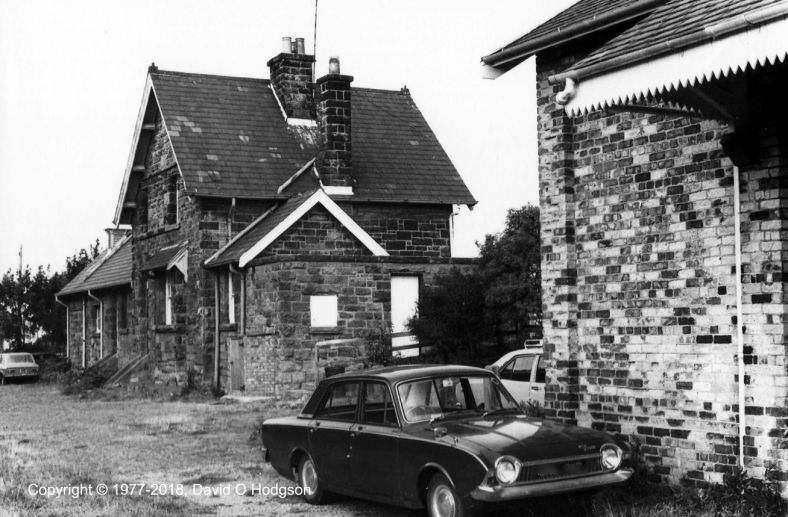
Pencil Drawing of Cloughton Station Gates, 1977
I produced the pencil drawing above in March 1977, as one of the regular weekly homework exercises for my Advanced-Level Art qualification.
The (now rather smudged) picture depicts a disused level crossing (grade crossing) gate that protected the tracks near the station at Cloughton. Cloughton was an intermediate stop on the Scarborough-Whitby line, which closed completely in 1965. The closure of that line set off a strange chain of events, which eventually led to worldwide fame for a similar station on a neighboring line.
My 1977 photo below shows a roadside view of the station building and goods shed at Cloughton, in a semi-derelict state.

Cloughton Station, 1977
These days, although Cloughton Station building still exists at that location, the crossing gate is long gone (as shown in this Google Streetview). On the other hand, thankfully the surviving station premises have been substantially renovated, and are now tea rooms, presenting a much cheerier scene than they did when I took my photographs during the 1970s.
Not Quite What Was There
As I recall, the goal of that homework assignment was to draw an outdoor scene, but I felt that that was a bit too much trouble, so, instead, I based my drawing on my own photograph of that scene! (Unfortunately, I no longer have that photograph.)
However, as you might expect from my approach to such artwork, if you’ve read my earlier posts on the subject, my drawing does not accurately reflect the real scene, because I felt that the composition could be improved, relative to the reality of what was there.
For example, my drawing shows a grounded railway wagon body on the left, next to the crossing. There was no such object at that crossing, although I’d seen similar carcasses in many other railway locations.
Nonetheless, my depiction of the gate itself is accurate. The North Eastern Railway, whose design it was, adopted a rather unusual practice of using extremely wide single gates to span multiple tracks, unlike most other railways (which would have used multiple gates in these cases). For my Advanced-Level Art architectural study, I eventually created a dimensioned drawing of a smaller gate of the same design at another station on the same line, Fyling Hall, as shown below.

Crossing Gate at Fyling Hall Station
From Heartbeat to Harry Potter
The Scarborough-Whitby railway was one of many targeted for closure by the notorious Beeching Report. There were many local protests regarding the planned closure of this line, and, during the 1964 national election, Harold Wilson of the Labour Party ran on a platform of promising to halt the Beeching-inspired closures. Unfortunately, it turned out that Wilson was just another lying politician, and after winning the election, he actually accelerated the closure schedule, as described in this post by transport commentator Christian Wolmar.
Following the closure, which took place on 6th March 1965, a fundraising effort began to try to buy up and reopen at least part of the Scarborough-Whitby route. Unfortunately, it appeared that the cost of repairs to structures on the line would exceed any conceivable budget, so the plan came to nothing.
However, the preservation effort then focused instead on another nearby line, which had been closed to passengers on the same day. This was the Whitby-Pickering Railway, which in fact was even more historic (albeit somewhat less scenic) than the Scarborough-Whitby route. The W&PR had originally been engineered by George Stephenson in 1836, and had relied on horse-drawn locomotion until it was connected to the national network in 1845.
As a result of all this, the North Yorkshire Moors Railway was formed, and began running trains in the early 1970s. I first visited the NYMR in 1975, and returned many times after that. The photo below shows Goathland Station on the NYMR in 1976, many years before it became world-famous.

Before the Days of Fame: Goathland Station in 1976
The preserved NYMR met with great success, and was eventually able to extend its route all the way from Grosmont (junction with BR) to Pickering. I took the photo below of an express hauled by A4 locomotive “Sir Nigel Gresley” in Pickering in 2006.

A4 “Sir Nigel Gresley” at Pickering, NYMR, 2006
The NYMR hired out its location for filming work, and, as a result, Goathland Station began to achieve recognition far beyond Yorkshire. During the 1990s, Goathland became “Aidensfield” in the TV soap opera Heartbeat, which ran from 1992 to 2010, and was broadcast around the world. The railway station appeared in many episodes.
Then, in 2001, Goathland Station appeared all around the world in movies, as the fictitious Hogsmeade Station in the Harry Potter films.
When I reluctantly produced that pencil drawing over 40 years ago, I couldn’t possibly have imagined the worldwide fame that was to come to some of those disused and derelict Yorkshire railways!
